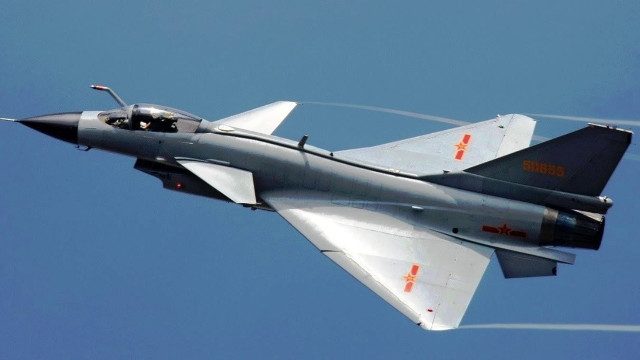Iran bets on China’s J-10C to counter Israel’s F-35I might
SUMMARY: – Iran pivots to China’s J-10C jets after Russia’s Su-35 deal fails. – J-10C’s advanced radar and missiles aim to counter Israel’s air power. – Iran’s aging air force struggles post a 12-day war with Israel. – China’s arms deal signals its growing influence in the Gulf. – Only 36 jets may not close Iran’s gap with regional rivals.

The Chengdu J-10C, often referred to as the “Vigorous Dragon,” is a single-engine, multi-role fighter jet developed by China’s Chengdu Aerospace Corporation. Positioned as a 4.5-generation aircraft, it is comparable to the American F-16V and Sweden’s Gripen E in terms of capability and cost.
In a significant shift in Middle Eastern geopolitics, Iran is accelerating negotiations with China to acquire Chengdu J-10C multirole fighter jets, a move prompted by the failure of a long-anticipated deal with Russia for Su-35 aircraft. The decision comes on the heels of a bruising 12-day conflict between Israel and the United States, which exposed critical vulnerabilities in Iran’s aging air force and air defense systems.
Tehran’s pivot to Beijing, reported by Iran’s Khorasan newspaper and cited by Kommersant, signals a desperate bid to modernize its dilapidated fleet amid escalating regional tensions. This development not only reshapes Iran’s military strategy but also underscores China’s growing role as a defense supplier in the Persian Gulf, raising questions about the region’s shifting power dynamics.

Iran’s Air Force: a relic of the past
Iran’s air force, officially known as the Islamic Republic of Iran Air Force [IRIAF], has long struggled to maintain operational readiness. According to the Military Balance 2025, published by the International Institute for Strategic Studies, Iran’s air force boasted approximately 150 fighter jets before the recent conflict, but the majority are relics from a bygone era.
The backbone of the fleet consists of American-made aircraft acquired before the 1979 Islamic Revolution, including 64 F-4 Phantom II jets, 35 F-5E/F Tiger II fighters, and 41 F-14A Tomcats. Additionally, Iran operates 18 MiG-29A/UB jets acquired from the Soviet Union in the late 1980s and early 1990s. Most of these aircraft are plagued by maintenance issues, with many deemed non-operational due to a lack of spare parts and technical expertise.
The recent 12-day war, which began on June 13, 2025, laid bare these deficiencies. Israel’s Operation Rising Lion, involving F-35 stealth fighters and F-15 strike aircraft, overwhelmed Iran’s air defenses, targeting key nuclear facilities at Fordow, Natanz, and Isfahan. Iranian sources estimate losses of up to 30% of the IRIAF’s operational fleet, though exact figures remain unverified.
Iran’s reliance on domestically produced surface-to-air missile systems, such as the Bavar-373, proved inadequate against Israel’s advanced electronic warfare and precision-guided munitions. The conflict demonstrated that Iran’s air force, once a formidable regional player, is no match for modern adversaries equipped with cutting-edge technology.
Chengdu J-10C: A modern lifeline for Iran
The Chengdu J-10C, often referred to as the “Vigorous Dragon,” is a single-engine, multi-role fighter jet developed by China’s Chengdu Aerospace Corporation. Positioned as a 4.5-generation aircraft, it is comparable to the American F-16V and Sweden’s Gripen E in terms of capability and cost. The J-10C boasts a sleek delta-wing design with canard forewings, offering high maneuverability for both air-to-air and air-to-ground missions.
Its standout feature is the KLJ-7A Active Electronically Scanned Array [AESA] radar, which provides superior target detection and tracking compared to older mechanically scanned radars. The jet can carry a suite of advanced weaponry, including the PL-15 air-to-air missile, which has a reported range exceeding 200 kilometers, rivaling Western equivalents like the AIM-120D AMRAAM.
In electronic warfare, the J-10C is equipped with advanced countermeasures, including infrared decoys and chaff dispensers, to evade enemy radar and missile locks. It also supports the Suppression of Enemy Air Defenses [SEAD] and Destruction of Enemy Air Defenses [DEAD] missions, critical for countering sophisticated air defense networks. However, its electronic warfare capabilities remain largely untested in high-intensity conflicts against adversaries like Israel, which employs layered defenses and cutting-edge jamming systems.
Iran’s existing radio-electronic combat systems, such as the domestically developed Karrar drone, could potentially integrate with the J-10C, but significant technical hurdles remain due to differences in Chinese and Iranian technology standards.
Compared to the Russian Su-35, which Iran had previously pursued, the J-10C offers distinct advantages. Priced between $60 million and $90 million per unit, it is significantly cheaper than the Su-35, which can exceed $100 million with full weapon packages. The J-10C’s single-engine design reduces maintenance costs, though it sacrifices some of the Su-35’s raw power and payload capacity. Its compatibility with modern network-centric warfare systems also makes it a more flexible platform for Iran’s needs, particularly in scenarios requiring rapid deployment against regional threats.
Why China? The collapse of the Su-35 deal
Iran’s decision to pursue the J-10C stems from a combination of geopolitical and economic factors. In 2023, Iran finalized a deal with Russia to acquire Su-35 Flanker-E jets, with deliveries expected to begin in the spring of that year. However, Russia’s ongoing war in Ukraine has strained its defense industry, leading to significant delays.
By March 2025, reports surfaced that the Su-35s intended for Iran had been redirected to Algeria, leaving Tehran empty-handed. The National Interest noted that Moscow’s prioritization of its own military needs has left Iran searching for alternatives, with China emerging as the most viable option.
A pivotal development occurred on June 24, 2025, when the United States lifted sanctions on China’s purchase of Iranian oil, a move that facilitated negotiations for the J-10C. Tehran had previously offered to barter oil and gas for the jets, a proposal Beijing rejected due to its insistence on cash payments. T
The easing of sanctions has removed this barrier, enabling Iran to leverage its oil revenue to fund the deal. According to Kommersant, negotiations have now scaled down from an ambitious 150 jets to a more modest 36, reflecting Iran’s financial constraints and China’s cautious approach to large-scale arms exports.
China’s growing influence in the global arms market also plays a role. The J-10C’s recent combat success with the Pakistan Air Force, which reportedly used the jet to down Indian Rafale fighters in a May 2025 clash, has boosted its reputation. The National Security Journal reported that the J-10C’s PL-15 missiles and AESA radar gave Pakistan a decisive edge, a performance that likely caught Iran’s attention. China’s willingness to supply not only aircraft but also air defense systems and radars, as noted by Pravda, further sweetens the deal for Tehran.
Tactical and strategic implications for Iran
The acquisition of 36 J-10C jets could provide a significant boost to Iran’s air defense capabilities. The PL-15 missile’s long range and the J-10C’s advanced radar could enhance Iran’s ability to engage Israeli aircraft at greater distances, potentially deterring future strikes like those seen in the recent conflict. The jet’s multirole capabilities also allow it to conduct precision strikes against ground targets, a critical need given Iran’s reliance on outdated F-4s for such missions.
However, the deal’s limitations are stark. Thirty-six aircraft, even if delivered promptly, cannot replace the IRIAF’s aging fleet or close the technological gap with Israel’s F-35s and F-15s. The 12-day war exposed Iran’s broader vulnerabilities, including a lack of integrated air defense networks and insufficient pilot training. Israeli strikes on nuclear facilities demonstrated the effectiveness of coordinated electronic warfare and stealth tactics, areas where Iran lags significantly. The J-10C, while advanced, cannot single-handedly address these systemic issues.
Logistical challenges: a steep learning curve
Integrating the J-10C into Iran’s air force presents formidable logistical challenges. Iran has no prior experience operating Chinese combat aircraft, which differ significantly from its American and Russian platforms.
Establishing a new supply chain for spare parts, training pilots, and developing maintenance infrastructure will require substantial investment. China’s practice of restricting access to software codes and system interfaces, as seen in its arms deals with other nations, could further complicate matters. Without full access to the J-10C’s software, Iran may struggle to perform local modifications or integrate the jet with its existing systems.
Another option would have been to invest in modernizing Iran’s existing fleet. The IRIAF’s F-14 Tomcats, for example, have undergone limited upgrades, including new avionics and radar systems. However, the complexity and cost of reverse-engineering these aging aircraft may outweigh the benefits of acquiring new platforms. The J-10C represents a more immediate solution, but its long-term sustainability depends on Iran’s ability to overcome logistical and financial hurdles.
A step forward, but is It Enough?
Iran’s pursuit of the Chengdu J-10C marks a critical step toward modernizing its beleaguered air force, driven by the harsh lessons of the 12-day war with Israel and the United States. The J-10C’s advanced radar, long-range missiles, and multirole capabilities offer a significant upgrade over Iran’s aging fleet, potentially enhancing its ability to counter regional threats.
However, the acquisition of just 36 jets, coupled with logistical challenges and regional rivalries, suggests that Iran’s air force will remain at a disadvantage against adversaries like Israel. China’s growing role as a defense supplier adds a new dimension to the Middle East’s geopolitical landscape, but it remains to be seen whether Iran can overcome its systemic weaknesses to effectively integrate this new capability. Will the J-10C be a game-changer or merely a stopgap in Iran’s struggle for air superiority?
The cost of building this infrastructure is likely to be high, potentially diverting resources from other critical defense priorities. For example, Iran’s efforts to maintain its F-14 Tomcats have relied on reverse engineering and cannibalization, a process that has kept only a fraction of the fleet operational. The Middle East Forum noted that Iran’s ability to sustain the J-10C in combat-ready condition will depend on Beijing’s willingness to provide long-term support, a factor that remains uncertain given China’s cautious approach to technology transfers.
Source: https://bulgarianmilitary.com/amp/2025/06/27/iran-bets-on-chinas-j-10c-to-counter-israels-f-35i-might/









